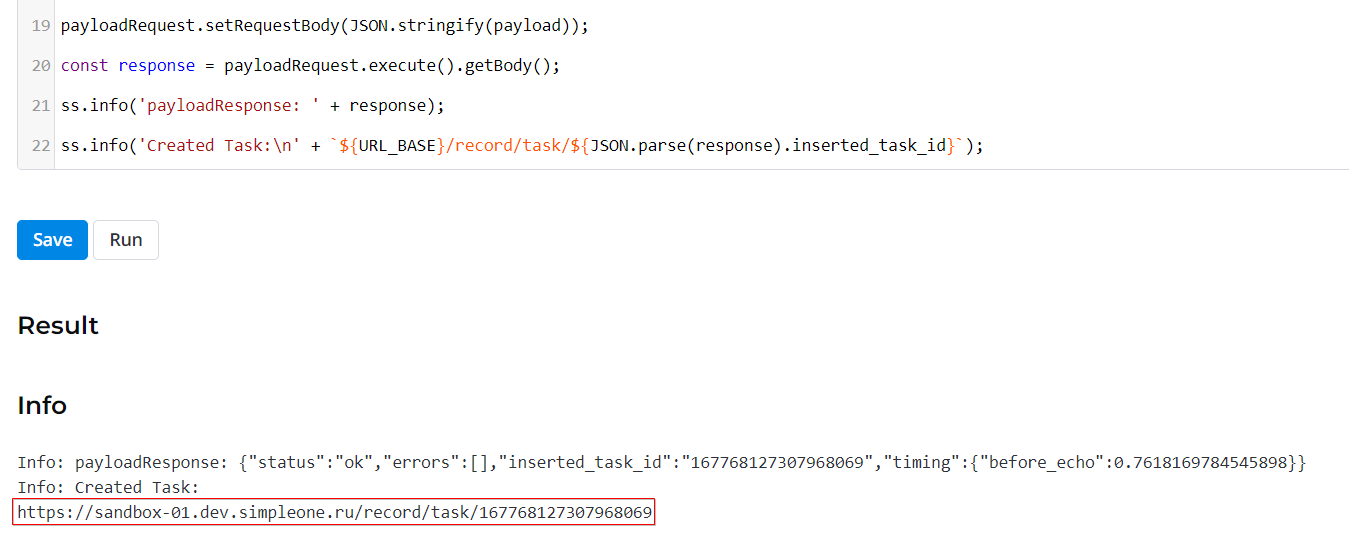To try the following scripted REST API examples, download the [SOC] - Scripted REST API package and import it to your instance.
Example 1. Get a system property value without authorization
To try the example:
- Go to the main page of your instance.
- Add to the URL bar the following value: /v1/api/c_simple/api_module_path/api_action_path?param_1=value_1.
- Copy the result URL.
- Go to the URL in Incognito mode.
As a result, you receive a response to the API action /record/sys_api_action/164054047017513732 with a system property value simple.auth_page.support_phone.
Example 2. Create a task record with an attachment
To try the example:
- Open the record /record/sys_script/164053985417710860.
- Click Run to run the script.
As a result, you receive a response to the API action /record/sys_api_action/161831494014244852.
On the bottom of the script form, there is a link to the created task record:

The record contains two attachments with the base64 files transferred in lines 14–15 of the script in Step 1.

Example 3. Create an attachment
You can create attachments using Scripted REST API. To pass file content, use the base64 format. To get a file content in base64 format, use the readBase64(attachmentId) method.
To send an attachment with the Scripted Rest API, do the following:
Create an API action to operate POST requests with the attached content.
(function (request, response) { const data = request.getBody(); const TABLE_ID = data.table_id; const RECORD_ID = data.record_id; const RECORD_DOC_ID = ss.getDocIdByIds(TABLE_ID, RECORD_ID); const attachments = data.attachments; const simpleAttach = new SimpleAttachment(); let createdAttachmentIds = []; Object.keys(attachments).forEach(attachment => { createdAttachmentIds.push(simpleAttach.writeBase64(RECORD_DOC_ID, ...attachments[attachment])); }); response.setBody(createdAttachmentIds); }) (SimpleApiRequest, SimpleApiResponse)Create a script to send the requests.
const API_ACTION_URL = ''; // https://docs.simpleone.ru/display/SAPI/Configuring+Scripted+REST+API#ConfiguringScriptedRESTAPI-ScriptedRESTAPIURIs const payloadRequest = sws.restRequestV1(); payloadRequest.setRequestUrl(API_ACTION_URL); payloadRequest.setRequestMethod('POST'); payloadRequest.setRequestHeader('Content-type', 'application/json'); const payload = { table_id: '155931135900000084', // user table ID record_id: '155931135900000001', // admin record ID record attachments: { 1: ['file_example.gif', 'R0lGODlhAQABAIAAAP///wAAACwAAAAAAQABAAACAkQBADs=', 'image/gif'] } } payloadRequest.setRequestBody(JSON.stringify(payload)); const response = payloadRequest.execute().getBody(); print('Response: ' + response);
For more information see the Configuring Scripted REST API article.
Features and recommendations
- API action script is executed regardless of the ACL.
- Authorization of requests to the Scripted REST API is not possible with Basic Auth. To authorize, use the solution described above in the Authorization section.
- A response to the API action containing a key error with a value Undefined index: SimpleApiResponse means the script API action contains an error.
- To avoid data corruption, convert JSON data type into type String using the JSON.stringify() method.

- If the execution time of the API action script exceeds the Timeout, move a part of the script to the Event Script and call a system event with an API action script.